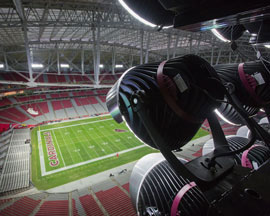Cronkite News has moved to a new home at cronkitenews.azpbs.org. Use this site to search archives from 2011 to May 2015. You can search the new site for current stories.
LED lighting to make Super Bowl debut in Glendale
Super Bowl XLIX is more than the New England Patriots and Seattle Seahawks playing for the Vince Lombardi Trophy under the bright lights in Glendale.
It also happens to be about the lights as well.
University of Phoenix Stadium will illuminate the Feb. 1 Super Bowl like no other previous NFL championship game before. The Patriots and Seahawks will be the first teams to compete for the title under an LED lighting system, which the stadium installed prior to the Arizona Cardinals and San Francisco 49ers game in September.
The use of LED lights for the game comes at a time when attention to detail has been critical in an NFL game. Look back at this postseason, where two games involving the Dallas Cowboys came down to calls made by the referees.
The company that brought the new lights to Glendale, Ephesus Lighting, designed and installed these lights to provide television audiences and replay officials more vivid detail.
Scott Norton, director of marketing and public relations at University of Phoenix Stadium, said media companies like ESPN and Fox have praised the stadium’s upgrades.
“The lighting is just amazing for slow-motion [replay] and HDTV,” Norton said.
The installation of the LED lights cut down the number of lighting fixtures by more than half, saving about 929,000 watts needed to power the fixtures, according to a case study Ephesus Lighting conducted.
Doug Drotman, the spokesman for Ephesus Lighting, said that number of watts is equal to about 15,000, 60-watt light bulbs. In layman’s terms, that equates to about the same amount of energy needed to power about 750 homes each using 20 of those bulbs.
In all, stadium officials expect the lights to save about 65 percent in electrical costs.
Another perk to having LED lights is they, unlike the old metal halide fixtures, do not generate heat. You can place your hand on a light and not burn yourself. With the old system, a person near the catwalks had to stand back from the lights because it felt like a wooden stove.
Also, no warm-up or cool down periods are necessary. A flick of a switch brightens, or dims, the stadium in less than a second. Just like home.
With improved power comes more responsibility. Since the end of the Fiesta Bowl, the NFL swooped into University of Phoenix Stadium to collaborate with its staff and prepare for the Super Bowl.
Remember, it was two years ago when another indoor stadium, the Superdome in New Orleans, endured a 34-minute power outage right after halftime of Super Bowl XLVII.
The stadium also increased the amount of power its backup system holds. A consultant inspected the system, shutting the building down and testing the backup system to make sure it worked properly.
“We’ve been hypervigilant in making sure all of our systems, not just electrical, are ready for all of the big events we will have here,” Norton said.
Salt River Project, the local power company, provides services to University of Phoenix Stadium.
In the event something goes wrong with the power or lights, the stadium will have a heavily staffed SRP group to help them, said Scott Harrelson, spokesman for SRP. The company has made upgrades to its primary and backup systems in the six months leading up to the Super Bowl.
“The stadium is in a location that is already robust with primary and backup services,” Harrelson said. “We are confident all energy needs will be met for the events.”
With preparation all but finished, all that’s left to do is wait to see who, or what, shines brightest. The Seahawks, the Patriots or the lights.







